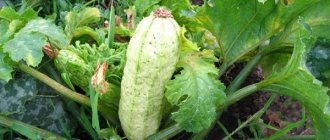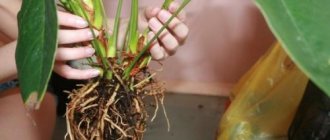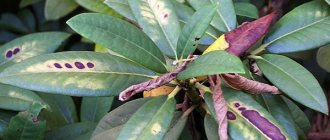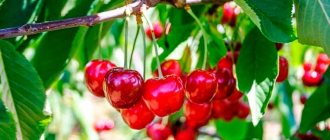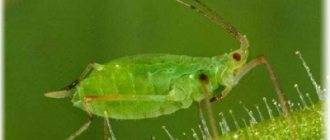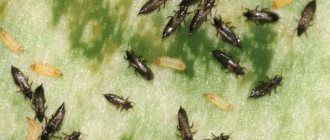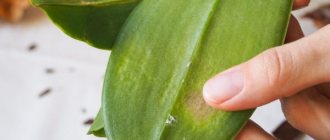Once I noticed that curled leaves appeared on some of the bell pepper bushes. It was immediately difficult to figure out that this was the result of a disease on the leaves of sweet pepper. And the fight against them by what means will be effective. The photo below captured the onset of leaf disease. Or maybe this is a lack of some nutrients in the soil, or pests prevent plants from developing normally. I began to look for the cause of the sweet pepper disease. It turned out that there are a lot of them and they are all different. The pepper needs treatment.
Photo, pepper leaves curled:

Top rot
Many gardeners consider apical rot to be an infectious disease caused by fungi and bacteria. This opinion is erroneous - the disease is physiological in nature. It manifests itself during the formation of fruits, which especially need calcium (Ca). Spots of whitish, yellow or brown color form on the tip of the peppers.
As the disease progresses, the affected areas grow, become dry, darker, pressed into the fetus. Affected vegetables stop developing and begin to quickly reach biological ripeness. Sometimes with apical rot, the crown of the stem dies off.
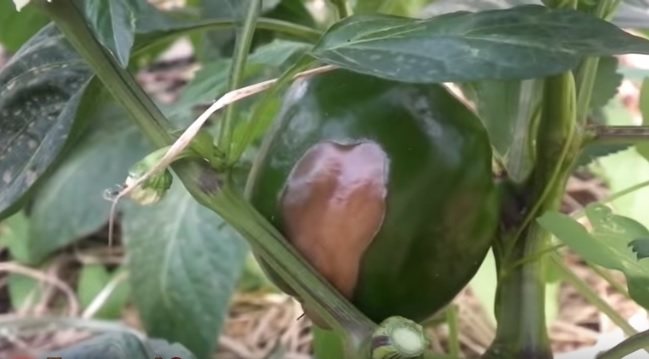

To properly fight the disease, you need to know the reasons why calcium starvation occurs in peppers. Interfere with the assimilation of the element by plants:
- acidic peat soils;
- watering with water with a high iron content;
- regular feeding with ash solutions;
- lack of moisture in the soil, drought;
- sudden changes in temperature.
The increased content of peat in the soil leads to its acidification; such soil is usually poor in calcium.
Iron and potassium are Ca antagonists. They impede its assimilation. Therefore, regular watering with water with a high iron content and ash solutions with a large amount of potassium can lead to the development of top rot. Ash contains calcium in a form that is difficult to access for plants, unlike K, therefore, such dressings should be used with caution.
Irregular watering also provokes illness. Plants cannot take the nutrient from the soil and become sick. Most often, this problem occurs in a greenhouse where the temperature is high. So that moisture does not quickly evaporate from the surface, experienced gardeners recommend mulching.
Sharp temperature changes affect the metabolism of peppers. They begin to poorly assimilate nutrients from the soil, and as a result, they develop apical rot.
Against the background of a decrease in immunity caused by calcium starvation, secondary fungal or bacterial infections may join. Therefore, at the first signs of the development of apical rot, urgent treatment should be carried out.
Chalk and dolomite flour are good sources of calcium. However, these substances contain the element in a difficult-to-find form for assimilation by peppers. Therefore, along with one of these components, table vinegar is used. For leaf processing and watering at the root, prepare the following solution:
A tablespoon of chalk or dolomite flour with a tubercle is dissolved in half a liter of 9% vinegar. The resulting concentrate is diluted with 10-12 liters of water.
If no ash fertilization was carried out and no potash fertilizers were applied, wood ash can be used instead of chalk or dolomite flour. A solution is being prepared according to the above recipe.
Some gardeners use calcium nitrate against top rot. However, this component is best used for preventive purposes before the formation of ovaries in the pepper.
An excess or lack of nutrition adversely affects the seedlings
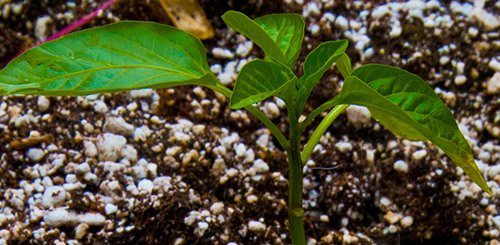

Sometimes peppers grow poorly in height due to an “overdose” of fertilizers. Often we feed the seedlings without thinking about whether the plant needs additional nutrition or not. And an overabundance of superphosphate, for example, can lead to the fact that the roots begin to develop faster than the ground part. As a result - stunting. In this case, feeding must be stopped and abundant watering must be ensured.
The opposite situation also happens, although much less often. If the peppers were grown in the purchased low-nutrient soil without top dressing, and then we planted them in poor, depleted soil, the slowdown in growth is quite predictable. Here, on the contrary, you will have to take up your mind and feed on schedule.


Fungal
Fungal diseases of pepper are more common than bacterial or viral diseases. Favorable conditions for their development are high humidity. Treatment methods largely depend on the type of pathogen. You can try to determine this or that disease by the photo of the leaves.
Late blight
Late blight is often popularly called brown rot. The disease is caused by Phytophthora filamentous organisms.
The first signs of a fungus attack on pepper are yellow and then brown spots on the leaves, a powdery bloom forms on the inside.
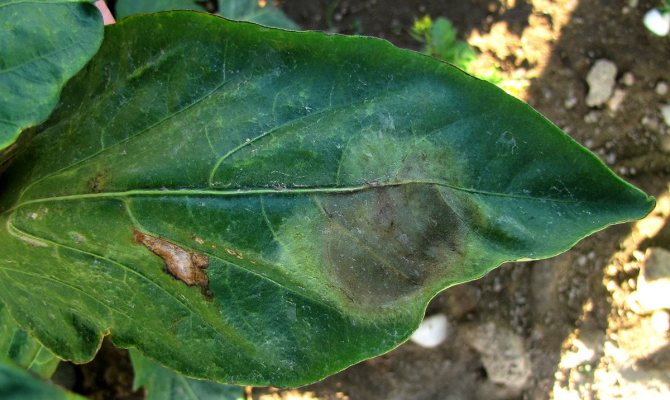

As the fungal disease progresses, the affected tissues die off, the leaf plates dry out and curl up. Black spots form on the fruits, which grow over time and lead to rotting of the vegetable. Such peppers become unfit for food.
Phytophthora most often affects crops in open field conditions. The peak of the disease occurs at the end of June. A high risk of developing a fungal epidemic arises in rainy and cool summers, when the temperature is at 20-25 degrees.
It is possible to save peppers from an epidemic only at the initial stage of the development of a fungal disease. All stems and leaves, on which traces of a phytopathogen are found, are cut off and the bushes are sprayed with saline (a glass of sodium chloride is diluted in 10 liters of water). Gardeners widely use Trichopolum in the fight against the disease. The solution is prepared from 20 tablets of the drug, which are diluted in a 10-liter bucket of water.
Milk serum with iodine gives good therapeutic results. Take 10-20 drops of iodine per liter of serum, dissolve the substances in 10 liters of water.
Prevention of fungal disease is reduced to the introduction of phosphorus-potassium fertilizers. As such a top dressing, gardeners use ash.
When choosing a variety, preference should be given to those resistant to late blight. Early ripe peppers leave the fungal infection.
For the purpose of prevention and treatment, fungicides such as Ridomil Gold, Champion, Skor.
Of the biological products, Fitosporin M is popular with gardeners. Preventive treatments are carried out 2-3 times per season.
A good remedy for the disease is a solution of copper sulfate:
Take 1/3 tsp. preparation, 200 gr. crushed laundry soap. The components are diluted in a 10 liter bucket of water. Pepper bushes are sprayed with the product.
The last treatment with chemicals is carried out no later than 20 days before the expected harvest.
Gray rot
The causative agent of gray rot is a fungus of the genus Botrýtis cinérea. This is the most common greenhouse pepper disease.
The fungal phytopathogen affects all vegetative organs: flowers, ovaries, stems, leaves, fruits.
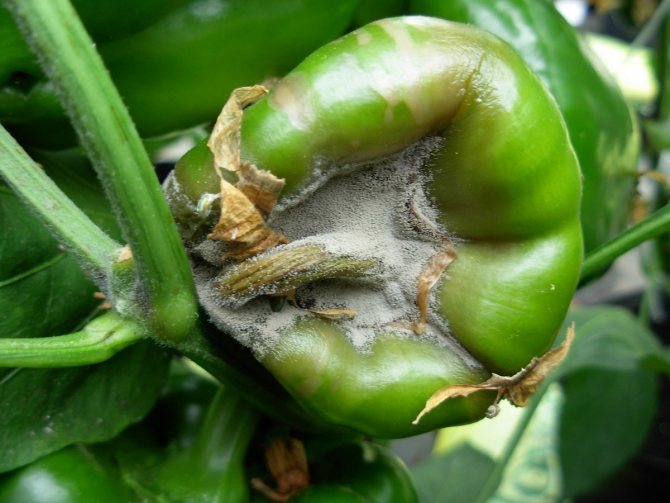

First of all, pathogens penetrate the lower leaves of the bushes. Then the pathogen moves to the stem of the peppers, forming dry spots of light brown color.
The fruits are initially affected in the area of the stalk. A gray spot is formed there, which rapidly increases in size, covering the entire fetus. Pepper rots, takes on a watery structure, a gray fluff appears on it.
At the first signs of damage, the plants are treated with the fungicides Switch, Fundazol or Luna Tranquility.
For the purpose of prevention and treatment, the drug Trichodermin is successfully used. The agent is introduced into the soil and sprayed with the aerial part of the peppers. The biological fungicide is diluted according to the instructions for use.
Anthracnose
The fungal disease of pepper is caused by the microorganism Colletotrichum capsici. Infected seeds, soil, plant debris contribute to the development of infection.
Anthracnose infects all aerial parts of the plant. Dark spots and sores form on the bushes, which are covered with a purple border, sometimes with a pink or orange tint. The necrotic areas gradually merge, the leaves acquire a brown color, dry out, and fall off.
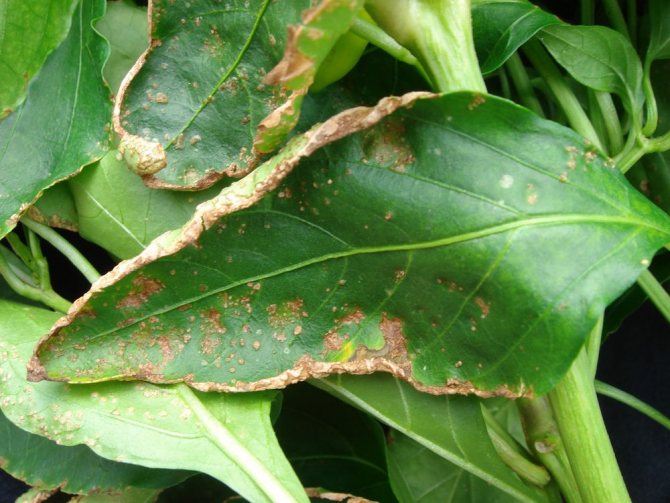

The most favorable conditions for the development of pepper anthracnose are high humidity at an air temperature of +22 degrees.
For the treatment and prevention of the disease, the chemical preparations Tiram or 1% Bordeaux liquid are used. Severely affected plant parts are cut and burned.
Observance of crop rotation and the destruction of all plant residues after harvesting allows to prevent the development of the disease. There are also varieties of peppers that are resistant to anthracnose.
Alternaria
The second name of the disease is black spot. The causative agent of the fungal infection is Alternaria capsici-annui.
Most often, peppers get sick with Alternaria in open ground, where the most favorable conditions for the development of a phytopathogen.


Outbreaks of the epidemic are observed in rainy and cool weather, as well as during the period of sharp changes in day and night temperatures.
Necrotic spots form on the leaf plates of pepper, which gradually merge. Drying and dying off of the leaves occurs. Black, depressed dots form on the fruit. The peppers that have tied up stop developing. The disease is difficult to cure. Sick bushes of peppers must be pulled out and burned. Other plants are sprayed with copper oxychloride (40 g of the drug per 10 l bucket of water) or Bordeaux liquid.
Withering (fusarium, wilt)
Fusarium and verticillary wilting have the same symptoms. However, these diseases are caused by different pathogens. Fungi of the genus Verticillium dahliae Kleb contribute to the development of wilt. Fusarium disease is provoked by the pathogenic microorganisms Fusarium.
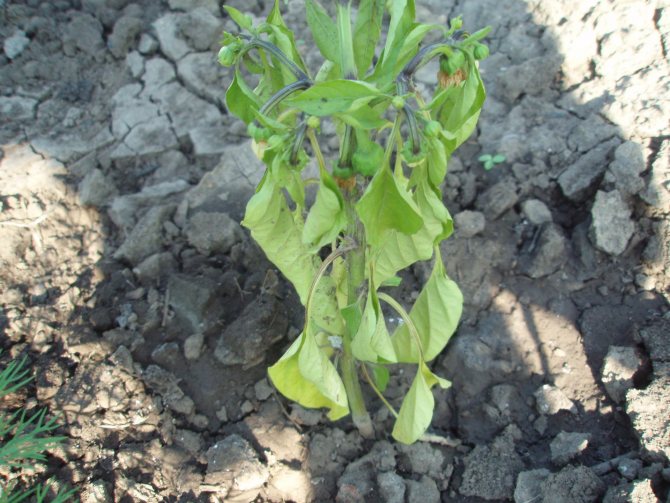

Withering refers to diseases of pepper seedlings, but it can also manifest itself on adult bushes after planting in a permanent growing place.
Initially, fungal spores infect the lower leaves, which develop yellow spots. Then the leaf plates turn completely yellow, dry up and fall off. The disease causes defoliation of plants: all the leaves to the crown die off and fall off. Infected bushes do not form ovaries. Fruits that have managed to set do not develop.
The most favorable conditions for the development of the disease are a temperature of +25 degrees and low soil moisture.
Infected plants are removed together with an earthen clod and burned. Healthy bushes are treated with drugs Maxim, Topsin-M.
Cladosporium
The source of the disease is the spores of the fungus Cladosporium fulvum. The second name of the infection is brown spot. The disease most often affects crops grown in greenhouses. The development of cladosporium occurs during the period of flowering and setting of pepper fruits.


Pathogens primarily affect the lower leaves, on which yellow spots are formed at first.Gradually they turn brown, a gray bloom appears. The leaves dry out and fall off. The yield decreases. Fruits that have managed to set up stop developing and ripen slowly.
Treatment is carried out with Barrier or Zaslon fungicides.
Non-communicable pepper diseases in the greenhouse
These diseases are safer than bacterial diseases, cause less damage to crops and do not infect nearby plants. Their appearance is provoked by the failure to comply with the rules for caring for pepper seedlings.
Throughout the growing season, seedlings need warmth, good watering, feeding and sunlight.
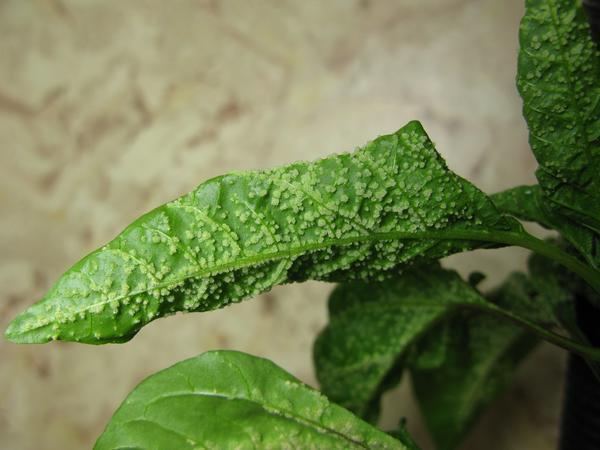

A lack of nutrients can lead to crop disease and reduced yields.
The disease can be provoked:
- Nitrogen is needed for the full development of plants and fruits. Its lack causes a decrease in inflorescences, a rare ovary, yellowing and wilting of leaves. The ovary dries up and falls off. To correct the situation, you need to feed with fertilizers.
- With a lack of phosphorus, the leaves and stem of the plant acquire a purple color. The lack of this substance can be corrected by adding special solutions to the water for irrigation.
- Potassium is needed to grow large fruit. Its lack leads to wilting, sagging and leaf fall.
- If the fruit sets and soon rot, there may be a lack of boron.
High temperatures and excessive moisture in the soil can also lead to rotting of the pepper, so the crops should be constantly monitored.
Bacterial
Bacterial diseases of sweet pepper are similar in description and appearance to many fungal infections. Therefore, it is often difficult to differentiate the type of phytopathology. In the fight against diseases of pepper, it is better to use drugs that simultaneously have antifungal and antibacterial effects.
Bell pepper bacterial cancer
Pepper disease is caused by the bacteria Clavibacter michiganensis. Bacterial cancer is characteristic of crops grown in southern regions and greenhouses.


The leaves become discolored, fall off, necrotic spots 1-3 cm in size appear on the fruits.At the initial stage of the development of the disease, the bushes are treated with copper-containing preparations or Fitolavin.
Black bacterial spot
The disease is provoked by the bacterial organisms Xanthomonas vesicatoria. On the infected leaves and stems, black specks of a watery character are formed. Lesions on leaf blades are usually located along the veins.
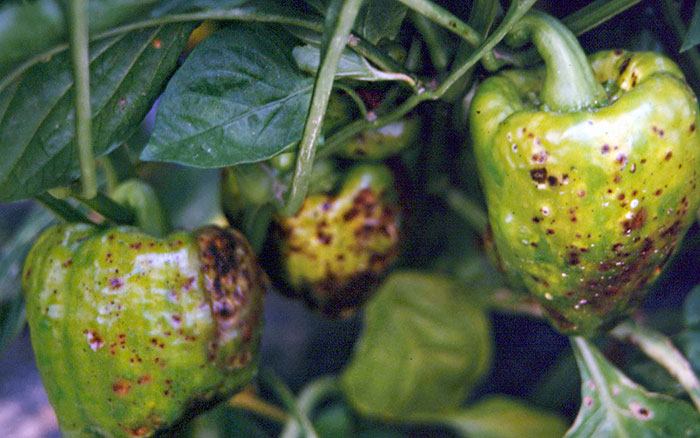

On the fruits, black bulging dots form, which gradually grow. The surface of diseased peppers becomes rough. The spots turn into sores, because of which the fruits begin to rot.
The rapid multiplication of bacteria occurs in humid conditions at temperatures from +25 to +30 degrees.
To combat the disease, fungicidal agents are used: Abiga-Peak, Bordeaux mixture.
Prevention of black bacterial spot is reduced to seed dressing before sowing, observance of crop rotation, spraying with Fitolavin.
Prophylaxis
Healthy plants are better able to resist twisting of the leaf plate. Therefore, it is necessary to provide proper care for the seedlings and regularly inspect the seedlings. Having noticed minor changes, you should immediately take measures to eliminate the pathology.
The main rules are reduced to preparing the soil for planting, soaking seeds in a solution of potassium permanganate, organizing sufficient illumination, feeding and controlling the moisture content of the nutrient substrate.
Pepper is a vegetable crop, capricious to growing conditions. A young plant reacts sensitively to non-compliance with growing standards, temperature conditions and soil composition. To grow healthy seedlings, you should regularly inspect the plantings for diseases and pests.At the first signs of leaf curling, the cause of the deformation must be eliminated.
Viral
Viral diseases of pepper reduce the yield of vegetable crops by 20-50% or more. Unlike bacterial and fungal phytopathologies, in which it is possible to save a diseased plant at the initial stage, viral infections lead to the inevitable death of infected bushes.
This nightshade crop is most often affected by:
- tobacco mosaic virus (TMV);
- cucumber mosaic virus (VOM);
- mottling virus;
- bronzing virus;
- stolbur.
Pests, in particular, various types of aphids, thrips, are the main distributors of pepper viral diseases.
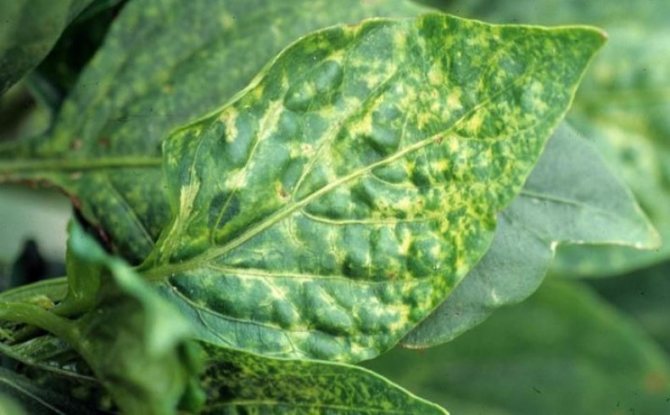

Symptoms of TMV are mosaic spots on the upper leaves with their further twisting in a boat, the development of dwarfism in diseased plants, sterility of flowers, the formation of chlorotic areas on fruits.
The signs of VOM and pepper mottling virus are identical to TMV.
Bronze virus appears as brown or olive spots on leaves and fruits. Dark brown or black stripes are formed on the stems.
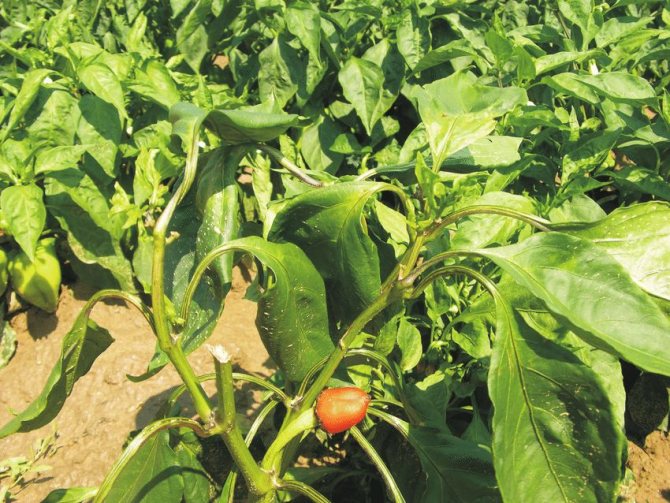

Pillar of pepper
Stolbur is more common in the south of the country. Disease carriers are cicadas. The upper leaves turn yellow, shrink and curl. The flowers become sterile, and the fruits that have time to set stop growing and become deformed. The pepper bushes are starting to fade.
There are no effective ways to fight viral diseases. Infected plants cannot be saved, only preventive measures are applied.
Prevention of viral diseases consists in using resistant varieties and hybrids to viruses, removing perennial weeds around the greenhouse, and treating plants from pests.
First signs
Folding the leaves of pepper seedlings is a signal of the presence of some problems in a young plant. Finding the probable cause of the curling of the leaves of pepper seedlings can take a lot of time. In order not to lose seedlings, it is necessary to differentiate the cause of the pathology in time and begin treatment with the appearance of the first symptoms.
It will be possible to determine that the leaves will soon be curling by the following signs:
- seedlings gradually lose their former brightness - the leaf plate begins to turn slightly yellow;
- the upper leaves take the shape of a boat - the edges are bent upward or downward inward;
- the appearance of cobwebs, white bloom, holes on the shoots is possible;
- deformation of leaflets along the longitudinal vein.
If you do not immediately take measures to save the seedlings, then the leaves of the young growth will curl up in two to four days and after a while the plant will die.
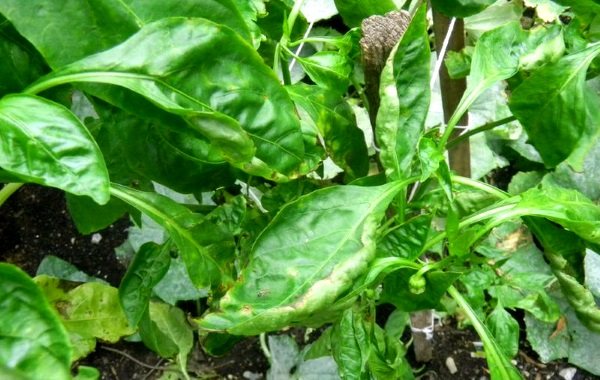

Pests
In the open field and in the greenhouse, bell peppers can infect phytophagous insects. Pests cause significant damage to vegetable growing, and with a sharp increase in the population, they can completely leave the gardener without a crop.
Nematodes
Nematodes are roundworms. They parasitize many plants, including sweet peppers.
There are three types of nematodes: root, stem and leaf. Most often, nightshade crops are affected by a pest that parasitizes the roots of plants.
Spread occurs through contaminated soil, soil and seed. It is more common in greenhouses due to the difficulty of maintaining crop rotation.
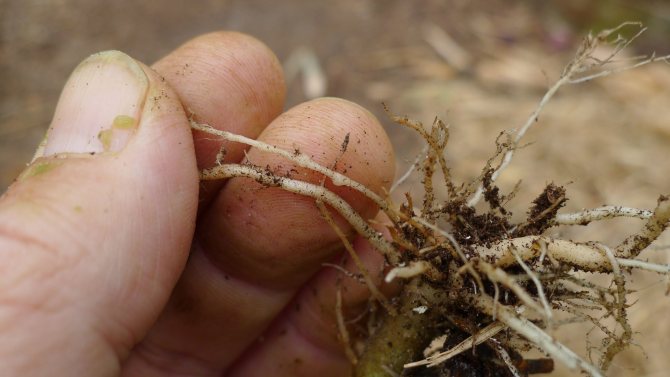

Peppers affected by the pest stop developing, chlorosis appears on the leaves. When a diseased plant is removed from the ground, galls can be found on the roots, which are spherical thickenings.
There are currently few effective remedies against nematodes. Traditional insecticides and fungicides do not affect the parasite, as it belongs to roundworms.
In the fight against the pest, the chemical Vidat or the biological product Nematofagin Mikopro is used.
Observance of crop rotation, checking the roots of plants at the end of the season, using mustard powder (half a glass of mustard per one well), adding Lepidocide or Bitoxibacillin to the soil will help to avoid the accumulation of nematodes.
Spider mite
Favorable conditions for the appearance of a spider mite on pepper are dry, hot weather with temperatures above +30 degrees. Most often, the pest is found in greenhouse conditions or in open ground in the south of the country.
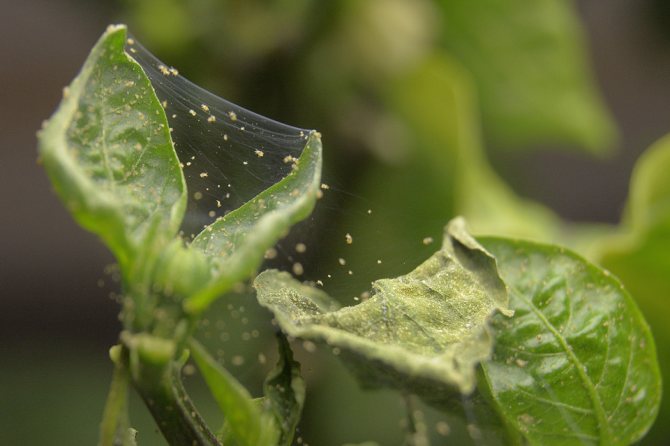

The parasitic population of the spider mite manifests itself on the plant by such signs as yellow specks on the leaf plates, a gray coating on the inside of the leaves that looks like dust, a barely noticeable cobweb on the aerial parts of the pepper.
Against the arachnid pest, Vermithek, Karbofos, Antimite, Sunmite and other acaricides are used. 3 treatments are carried out with an interval between each of 7-10 days. It is advisable to alternate drugs so as not to cause resistance in the parasite.
Aphids
Aphids are most often found in greenhouse conditions. The spread of pests is the soil infected with their larvae.
Ants can contribute to the reproduction of the aphid population. The latter feed on the sweet honey secreted by insects and act as their natural protectors. When fighting aphids, first of all, you need to destroy all anthills on the garden plot.
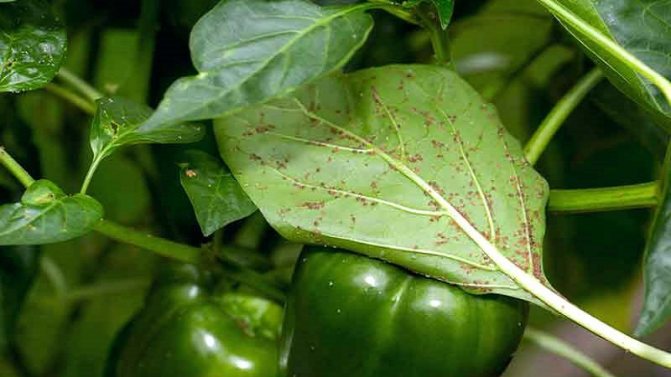

The pest is a carrier of viral diseases that threaten the complete death of plants.
When pepper is affected by aphids, a sticky pad appears on the vegetative organs, the leaf plates curl, the buds do not open, and the flowers that appear are deformed and fall off.
For the destruction of pests, insecticides such as Intavir, Actellik and Karbofos are used. In greenhouses, peppers are treated with Clipper. From biological products Fitoverm, Entobacterin, Aktotsid are used.
Caterpillars of the scoop
Caterpillars feed on leaves, stems, and pepper roots. In the daytime they hide in the ground, with the onset of dusk they creep out.


Moths attack plants in greenhouses, hotbeds and open field. Increased moisture contributes to the rapid increase in the pest population.
In the fight against caterpillars, scoops use the preparations Gerold, Alatar, Decis Profi, Initiator 200.
Thrips
The main signs of the appearance of thrips on pepper are deformation of the leaf plates, the appearance of yellow spots on the leaves, and the falling off of flowers.
To destroy the pest, peppers must be treated three times with an interval of 10 days with such preparations as Aktara, Fitoverm.
Bedbugs
The pest bites through the fruits of the pepper and injects poisonous juices. Pepper becomes unsuitable for food, as it acquires a bitter taste and a specific smell, and quickly decays.
Insecticides used against pests such as whitefly and aphids are effective against bedbugs.
Nightshade miner
The pest affects bitter and sweet peppers, both in open and closed ground. The larvae of the nightshade miner are dangerous to plants. They are embedded in sheet plates, gnawing through passages in them.
Favorable conditions for the development of the pest - temperatures from +25 to +30 degrees.
Against the nightshade miner on peppers, such remedies as Spinosad, Vermithek, Varant, Tianid are effective.
Slugs
Favorable conditions for the reproduction of slugs are temperatures up to +25 degrees and high humidity. The pest eats at night.
Molluscs gnaw through the leaf plates, leaving holes of different sizes on them. The fight against them is carried out with the help of drugs Slizneed, Thunderstorm Meta, Ferramol.
Wood ash or hydrated lime will also help get rid of slugs. Substances are sprinkled on the soil around the pepper bushes.
Wireworm
These pepper pests are the larvae of the click beetle. They live in the ground at a depth of 10-12 cm, feed on the roots of nightshade and other vegetable crops.
Effective methods of combating wireworm are the use of drugs and sowing siderates.For preventive purposes, Zemlin and Vallar are used.
It is possible to remove the pest with the help of siderates only the next season after its detection.
After harvesting and removing plant residues from the site, rye or mustard is sown. They serve not only as fertilizer, but also as a wireworm control. In the spring, after the emergence of siderat seedlings, the site is dug up, after which the seedlings can be planted.
Useful Tips
You can provide peppers with a favorable environment for development and fruitingby following the advice of experienced gardeners:
- Pay close attention to the quality of the seeds. If you are not sure of them, before sowing for disinfection, first hold for 20 minutes in potassium permanganate, and then, after thoroughly rinsing with water, for 12 hours in the preparation "Zircon".
- Do not plant seedlings too early. The optimal time is between mid-March and early April. In this case, you will keep the plant in a stuffy room much less.
- Remove plant parts left in the soil after harvest. Some of them can leave on themselves disease-causing fungi, bacteria and viruses that are not afraid of winter. Crop rotation may not be enough - only burning all plant residues will be an effective solution.
Possible causes of foliage deformation
There are several reasons why pepper leaves lose their usual shape and color. These are care errors, pests and diseases.
Deformed leaves are a serious problem that can lead to complete loss of crops, death of plants.
Uneven growth of the leaf plate
The leaf plate deforms when the lateral veins form more slowly than the central one. Uneven development of leaves is temporary. It can occur during sudden cold snaps, when the normal nutrition of the peppers is disrupted. Foliar dressing quickly solves the problem.
See also
Description of Kakadu pepper, indoor cultivation and pest control
To read
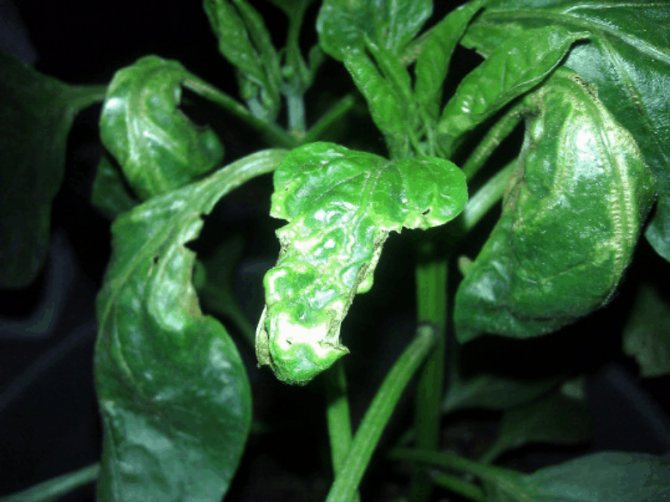

Deficiency of essential elements in the soil
Various nutrients are needed for the normal development of pepper. Their lack in the soil affects the condition of the aboveground part of the plant.
| Element | Deficiency signs |
| Magnesium | Pale leaves, pale pink around the veins, curled edges |
| Potassium | The edge is dry, the plate is shaped like a boat |
| Nitrogen | Leaves are thin, twisted, with yellow specks |
| Phosphorus | Red-purple shade |
| Calcium | The leaf plates are twisted, covered with gray-yellow spots |
Bumps on the leaves - what could it be?


The main factors that provoke such damage to seedlings are:
- Improper care. This is affected by either excessive soil moisture, or lack of light and fresh air, or both reasons in combination.
- Diseases. Peppers most often infect such pests as spider mites, scale insects, aphids.




